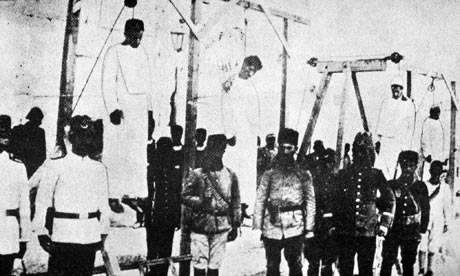guardian.co.uk
Friday 5 March 2010 12.11 GMT
Repression of 2.5 million people in Ottoman empire dates back to
autonomy movement in late 19th century

Ottoman soldiers posing in front of hanged Armenians in 1915. A US
congressional committee yesterday voted to label the Ottoman empire’s
actions as genocide. Photograph: AFP/Getty Images
Armenia believes Turkey committed genocide in the deaths of at least
1 million Armenians when they were deported from Turkish Armenia in
1915, and welcomes the non-binding resolution passed by the US house
foreign affairs committee.
Repression of the 2.5 million Armenians in the Ottoman empire dates
back to 1894-96 under Sultan Abdulhamid, when Armenians in the eastern
provinces, encouraged by Russia, began agitating for autonomy.
Abdulhamid cracked down on separatist sentiment by encouraging
nationalistic feelings against Armenians among neighbouring Kurdish
tribesmen.
A combination of Kurdish persecution and a rise in taxes led to an
Armenian uprising that was brutally suppressed by Turkish troops
and Kurdish tribesmen in 1894. Thousands of Armenians were killed
and their villages burned. Two years later, another revolt broke
out when Armenian rebels seized the Ottoman bank in Istanbul. More
than 50,000 Armenians were killed by mobs apparently co-ordinated by
government troops.
Those death tolls were dwarfed by the killings during the first world
war, when Armenians from the Caucasus formed volunteer battalions
to help the Russian army against the Turks. Early in 1915, these
battalions organised the recruiting of Turkish Armenians from behind
Turkish lines.
The Young Turk government reacted by ordering the deportation of the
Armenian population to Syria and Palestine. About 1 million died from
starvation or were killed by Arab or Kurdish tribes along the route.
Many survivors fled to Russian Armenia where, in 1918, an independent
Armenian republic was established. Armenia won independence when the
Soviet Union fractured in 1991.
Turkey accepts that atrocities took place but argues that there was
no systematic attempt to destroy the Christian Armenians. It puts the
number of deaths during 1915 at around 300,000 and says many innocent
Muslim Turks also died in the turmoil of war.
The legal definition of genocide is found in the 1948 UN convention
on the prevention and punishment of the crime of genocide.
Article two of this convention defines genocide as “any of the
following acts committed with intent to destroy, in whole or in part,
a national, ethnical, racial or religious group, as such: killing
members of the group; causing serious bodily or mental harm to members
of the group; deliberately inflicting on the group conditions of life
calculated to bring about its physical destruction in whole or in
part; imposing measures intended to prevent births within the group;
[and] forcibly transferring children of the group to another group.”
Henri Barkey, a Turkey scholar at the Carnegie Endowment for
International Peace in Washington DC, said that “the overwhelming
historical evidence demonstrates that what took place in 1915 was
genocide”. He nevertheless opposes the US ruling as a needless
political manoeuvre.
Argentina, Belgium, Canada, France, Italy, Russia and Uruguay are among
more than 20 countries which have formally recognised genocide against
the Armenians. The European parliament and the UN sub-commission on
prevention of discrimination and protection of minorities have also
done so.https://www.theguardian.com/world/2010/mar/05/history-armenia-turkey-genocide

Leave a Reply